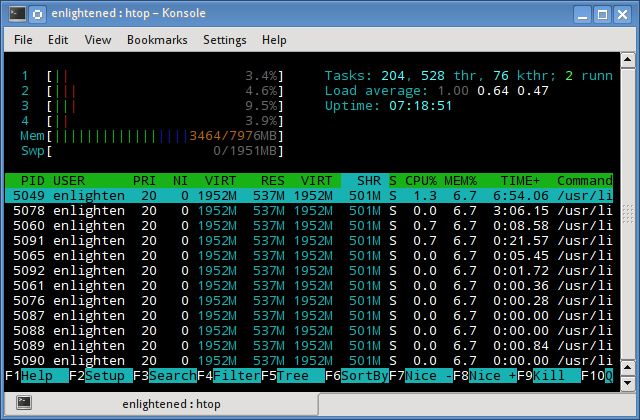5 commands to check memory usage on Linux
On linux, there are commands for almost everything, because the gui might not be always available. When working on servers only shell access is available and everything has to be done from these commands. So today we shall be checking the commands that can be used to check memory usage on a linux system. Memory include RAM and swap.
It is often important to check memory usage and memory used per process on servers so that resources do not fall short and users are able to access the server. For example a website. If you are running a webserver, then the server must have enough memory to serve the visitors to the site. If not, the site would become very slow or even go down when there is a traffic spike, simply because memory would fall short. Its just like what happens on your desktop PC.
1. free command
The free command is the most simple and easy to use command to check memory usage on linux. Here is a quick example
$ free -m total used free shared buffers cached Mem: 7976 6459 1517 0 865 2248 -/+ buffers/cache: 3344 4631 Swap: 1951 0 1951
The m option displays all data in MBs. The total os 7976 MB is the total amount of RAM installed on the system, that is 8GB. The used column shows the amount of RAM that has been used by linux, in this case around 6.4 GB. The output is pretty self explanatory. The catch over here is the cached and buffers column. The second line tells that 4.6 GB is free. This is the free memory in first line added with the buffers and cached amount of memory.
Linux has the habit of caching lots of things for faster performance, so that memory can be freed and used if needed.
The last line is the swap memory, which in this case is lying entirely free.
2. /proc/meminfo
The next way to check memory usage is to read the /proc/meminfo file. Know that the /proc file system does not contain real files. They are rather virtual files that contain dynamic information about the kernel and the system.
$ cat /proc/meminfo MemTotal: 8167848 kB MemFree: 1409696 kB Buffers: 961452 kB Cached: 2347236 kB SwapCached: 0 kB Active: 3124752 kB Inactive: 2781308 kB Active(anon): 2603376 kB Inactive(anon): 309056 kB Active(file): 521376 kB Inactive(file): 2472252 kB Unevictable: 5864 kB Mlocked: 5880 kB SwapTotal: 1998844 kB SwapFree: 1998844 kB Dirty: 7180 kB Writeback: 0 kB AnonPages: 2603272 kB Mapped: 788380 kB Shmem: 311596 kB Slab: 200468 kB SReclaimable: 151760 kB SUnreclaim: 48708 kB KernelStack: 6488 kB PageTables: 78592 kB NFS_Unstable: 0 kB Bounce: 0 kB WritebackTmp: 0 kB CommitLimit: 6082768 kB Committed_AS: 9397536 kB VmallocTotal: 34359738367 kB VmallocUsed: 420204 kB VmallocChunk: 34359311104 kB HardwareCorrupted: 0 kB AnonHugePages: 0 kB HugePages_Total: 0 HugePages_Free: 0 HugePages_Rsvd: 0 HugePages_Surp: 0 Hugepagesize: 2048 kB DirectMap4k: 62464 kB DirectMap2M: 8316928 kB
Check the values of MemTotal, MemFree, Buffers, Cached, SwapTotal, SwapFree.
They indicate same values of memory usage as the free command.
3. vmstat
The vmstat command with the s option, lays out the memory usage statistics much like the proc command. Here is an example
$ vmstat -s 8167848 K total memory 7449376 K used memory 3423872 K active memory 3140312 K inactive memory 718472 K free memory 1154464 K buffer memory 2422876 K swap cache 1998844 K total swap 0 K used swap 1998844 K free swap 392650 non-nice user cpu ticks 8073 nice user cpu ticks 83959 system cpu ticks 10448341 idle cpu ticks 91904 IO-wait cpu ticks 0 IRQ cpu ticks 2189 softirq cpu ticks 0 stolen cpu ticks 2042603 pages paged in 2614057 pages paged out 0 pages swapped in 0 pages swapped out 42301605 interrupts 94581566 CPU context switches 1382755972 boot time 8567 forks $
The top few lines indicate total memory, free memory etc and so on.
4. top command
The top command is generally used to check memory and cpu usage per process. However it also reports total memory usage and can be used to monitor the total RAM usage. The header on output has the required information. Here is a sample output
top - 15:20:30 up 6:57, 5 users, load average: 0.64, 0.44, 0.33 Tasks: 265 total, 1 running, 263 sleeping, 0 stopped, 1 zombie %Cpu(s): 7.8 us, 2.4 sy, 0.0 ni, 88.9 id, 0.9 wa, 0.0 hi, 0.0 si, 0.0 st KiB Mem: 8167848 total, 6642360 used, 1525488 free, 1026876 buffers KiB Swap: 1998844 total, 0 used, 1998844 free, 2138148 cached PID USER PR NI VIRT RES SHR S %CPU %MEM TIME+ COMMAND 2986 enlighte 20 0 584m 42m 26m S 14.3 0.5 0:44.27 yakuake 1305 root 20 0 448m 68m 39m S 5.0 0.9 3:33.98 Xorg 7701 enlighte 20 0 424m 17m 10m S 4.0 0.2 0:00.12 kio_thumbnail
Check the KiB Mem and KiB Swap lines on the header. They indicate total, used and free amounts of the memory. The buffer and cache information is present here too, like the free command.
5. htop
Similar to the top command, the htop command also shows memory usage along with various other details.
The header on top shows cpu usage along with RAM and swap usage with the corresponding figures.
RAM Information
To find out hardware information about the installed RAM, use the demidecode command. It reports lots of information about the installed RAM memory.
$ sudo dmidecode -t 17 # dmidecode 2.11 SMBIOS 2.4 present. Handle 0x0015, DMI type 17, 27 bytes Memory Device Array Handle: 0x0014 Error Information Handle: Not Provided Total Width: 64 bits Data Width: 64 bits Size: 2048 MB Form Factor: DIMM Set: None Locator: J1MY Bank Locator: CHAN A DIMM 0 Type: DDR2 Type Detail: Synchronous Speed: 667 MHz Manufacturer: 0xFF00000000000000 Serial Number: 0xFFFFFFFF Asset Tag: Unknown Part Number: 0x524D32474235383443412D36344643FFFFFF
Provided information includes the size (2048MB), type (DDR2) , speed(667 Mhz) etc.
Summary
All the above mentioned commands work from the terminal and do not have a gui. When working on a desktop with a gui, it is much easier to use a GUI tool with graphical output. The most common tools are gnome-system-monitor on gnome and
ksysguard on KDE. Both provide resource usage information about cpu, ram, swap and network bandwidth in a graphical and easy to understand visual output.
A Tech Enthusiast, Blogger, Linux Fan and a Software Developer. Writes about Computer hardware, Linux and Open Source software and coding in Python, Php and Javascript. He can be reached at [email protected] .
67 Comments
Free vs. Available Memory in Linux
At times we will need to know precisely how our Linux systems use memory. This article will examine how to use the free command-line utility to view memory usage on a Linux system. In doing so, we will clearly define the difference between free vs. available memory on Linux systems.
Free vs. Available memory explained.
Ok, let’s get right to it then. What exactly is free memory and how is it different from available memory?
Free memory is the amount of memory that is currently not used for anything . For this reason, especially on servers, I like to consider free memory as wasted memory. Once your applications/processes have launched and considerable uptime has passed, this number should almost always be small.
Available memory is the amount of memory that is available for allocation to new or existing processes. Available memory is then an estimation of how much memory is available for use without swapping .
The difference between free memory vs. available memory in Linux is, that free memory is not in use and sits there doing nothing. While available memory is used memory that includes but is not limited to caches and buffers, that can be freed without the performance penalty of using swap space.
Sponsored: ManageEngine – Application performance monitoring made simple
ManageEngine’s Application Manager is a web-based APM and IT infrastructure management tool that provides a centralized console for managing various applications and underlying infrastructure. It supports monitoring of technologies such as web and application servers, databases, virtual systems, and cloud environments. It offers real-time performance monitoring, analytics, alerting, root cause analysis, and reporting. It also supports custom scripting and task automation for application performance management. — Read more.
Free vs. Available memory compared.
With this in mind, let’s look at two 60GB memory Linux servers. Server A and Server B . We are going to use the go-to command: free
To view free vs. available memory in Linux, login to your server and enter the following command:
The result should look something like these two screenshots below. I also ran the uptime command to confirm that both systems have been online for some time.
Server A: Has less than 1% free (wasted memory), 13GB available memory.
Server B: After 153 days of uptime, 30GB of memory is still wasted (free).
Above lies the difference between free vs. available memory in Linux. When you compare both systems, even though the load averages are similar (processing the same workloads), it is evident that one server is making use of almost 100% of its memory ( Server A ) while the other server is wasting more than 50% of its memory ( Server B ). Note, that both of these servers have 12 CPU cores and swap to RAID 10 NVMe storage – thanks to StackLinux.com.
Please note that the Linux Kernel will move memory pages least frequently used into swap space even if there is available memory.
When analyzing these systems, a sysadmin may ask a few pertinent questions: Is swapping slowing the performance of Server A? Or, is it opportunistic swapping? Should we downgrade memory on server B? Or, is traffic/workload growth expected soon? Should Server A be upgraded with more memory? Or, during peak hours/swap, does “load average” stay well below 12.00? Can Server B be configured to use more buffers and cache? Would such a change improve performance (is it worth changing)?
These are the questions that resulted in the current state of those above servers. Each admin will have to answer those questions and others, case by case, or hire an expert to do so.
Conclusion
Don’t be caught looking at “free” memory on your Linux system and jumping to conclusions because you should also consider available memory, buffers/caches and other factors as outlined.
I’ve written some other articles on this topic that you may find helpful:
In addition to the free command, you can also use the following commands to check your Linux system’s memory usage:
- top – shows an overall system view.
- htop – interactive process viewer and manager.
- atop – For Linux server performance analysis.
- Glances and nmon – htop and top Alternatives.
- vmstat – shows system memory, processes, interrupts, paging, block I/O, and CPU info.
- cat /proc/meminfo and others.
Thanks for reading. I am looking forward to hearing from you!
Published: September 7th, 2021 | Last updated: July 27th, 2022




